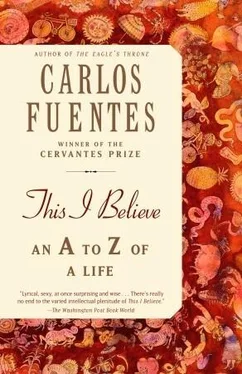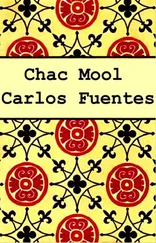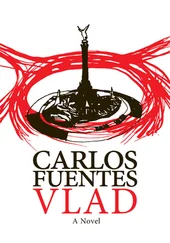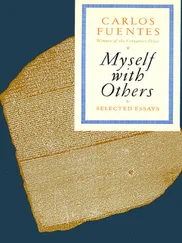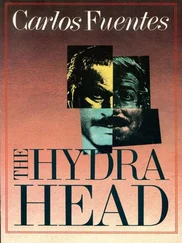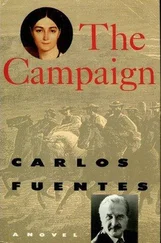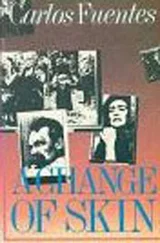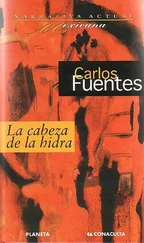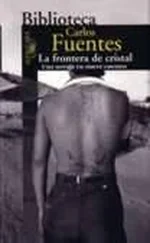But then shouldn’t there exist, even in the most complete love, an anticipation of loss that intensifies the sexual present? Sometimes, as I watch Silvia sleep, I wish I could steal her name, her appearance, her experience from her, so that I could be the absolute master of her existence, the jealous guardian of her secrets. Without her, I can only conceive of love standing before a mirror, trembling from the memory of her. And then, disturbed and hungry, I hastily return to her closeness. I treat her body as if it were mine. With Silvia I learn to feel both passion and respect for the female body united with mine. I only praise her in the name of the perfection that I ascribe to her, even if she does not possess it, the perfection that she offers up to me, even though she may not see it.
Every night I leave an invisible note on her pillow that says, “I like you.”
Women are the fleeting voyagers of the dawn. Each one is the bearer of a different destiny. My destiny was to find Silvia and to make all that is mine hers.
Quite some time ago, I was traveling through the Mexican state of Morelos with the New York playwright Jack Gelber and his wife. Having lost our way in the labyrinth of mountains, rice fields, and reedbeds, we stopped to ask an elderly local gentleman the name of the village we were in.
“It depends,” the old man replied. “When there is peace, the village is called Santa María. And when there is war, Zapata.”
That old country gentleman knew something that “modern times” seem to have forgotten: that there exists more than one time in the world. There exist other times, in the plural — alongside, above, or below the lineal times marked by our Western calendars.
An old man who could live depending either on Zapata time or on Santa María time was the living heir to a complex, multilayered culture. That man is indispensable to us and, perhaps more important, he is fraternal. He reminds us that he has a brother in India for whom the past is never the past but rather an eternal present, forever enriched by what the West considers to be the dead “past.” I suspect he has a twin in China who conceives of time as a purely dynastic proposition, and perhaps a nephew somewhere in Morocco for whom time does not evolve at all horizontally from past to present to future, but rather as the vertical, parallel ascent of God and man.
I can even imagine that perhaps he has a young grandson living in Madagascar among the imerima who refuse to banish ancient times in order to make way for newer ones. Rather than mutually reject one another, each of them comes together to comprise a kind of continuous accumulation. Everything is alive, and everything is present, now and always. The imerima perceive all possible history as two declining realities: the legacy of the ears and the memory of the lips. And as we enter the twenty-first century, ears and lips tell us that we should broaden the channels through which time flows, so that we can give both life and space to the manifold cultures of a world that runs the risk of both global uniformity and local dispersion. For this, we must examine the notion of time as we see it from inside our traditional Western patterns, which means we must examine our concept of future-oriented history, the notion of progress as an inevitable linear ascent toward perfection and, finally, the question of international hegemony and servitude in the twenty-first century because the modern world also offers us the possibility of a time without time, a time that might be the end of time if, as is eminently possible, we manage to murder nature and commit suicide in the process.
The defense of time is, as such, the defense of culture and the way we experience it throughout our history. That defense has a dwelling place. It is called the present, the here and now. The past occurs today, when we remember. And the future occurs today, too, when we desire.
A living present cannot exist if the past is dead. We can throw the past out the window, but it won’t be long before it comes right back at us through the front door, often in the strangest of guises. Wars that fight memory are ultimately lost by those who incite them. We must turn the past into the present if we want to understand the reemerging cultures that are dissatisfied with the headlong race toward a headless future. We must do this so that we can understand the internal tension in those cultures, the tension that merges the technical, supra-national demands of the global village and the affirmation of local differences, regionalism, microcultures, and the rhythms of time that are their individual legacies.
All these tensions call upon us to reformulate our concept of temporality and the role of language and imagination in the interest of a redistribution of our shared civilizations so that we may coexist with deeper and less ephemeral traditions than our own. Mexico is a multicultural, Spanish-speaking country, but it also continues to be an indigenous country as well. A whole repertoire of possibilities that we have forgotten, postponed, or expelled from our own concept of progressive time quietly awaits us in the indigenous world, repository of all that we have forgotten and scorned: the intensity of ritual, atavistic wisdom, mythic imagination, the death relationship, the method of marking the passage of time — narration and sum — not only in the calendar of the sun but in the calendar of destiny, the tonopuhali of twenty-day cycles, each one with its own discrete, thirteen-day unit. We need to do this until we can assimilate a veritable mandala that reflects a more comprehensive, more expansive concept of time, oriented beyond our simple linear conceptions.
Time has always been a problem. Ever since the beginning of time. It is a redundant problem, for the problem of time is time itself. The root of the problem is that there are two ways to perceive it. From one point of view, reality is defined by constant change. The world is in flames. The law of opposites is bloody. Everything tends to become its opposite and this is what effects change. History is the history of violence. Time is struggle. Evolution and flow are the only temporal realities. If movement ceases, the universe collapses and time stops.
From the other point of view, only that which is permanent and lasting is real. Flow, movement, and change are merely cosmetic. Plato reconciled both sides but favors the second. If change is real, permanence is unreal. Plato’s dualism tells us that there exists a world of forms, real and permanent, outside of time and free of change: an eternal world. But there also exists another world, one of sensory objects, predicated upon appearance and change, which reflects the world of forms in another world of changing times. In Timaeus, the Creator explains how He transformed original Chaos into Universal Order. The immensity of God does not rely on space. The eternity of God does not rely on time. But as time and space are occupied by things and events, those things and events coexist in space and occur in time.
Lessing divided the arts into forms that coexist in space (in painting and sculpture, arts of total and immediate impression), and forms that occur over time (music and literature). Hence, the great question posed by modern literature has been: why is writing beholden to succession instead of simultaneity? Because language is composed of successive, discrete units. To a large degree, the revolution of the modern novel resides in its rebellion against discrete, successive inevitability. But the same thing is true of music, physics, and poetry. The impossible dream of simultaneity rebels against succession, and transforms rather than destroys it: Picasso, Pound and Eliot, Apollinaire, Joyce, Faulkner, Virginia Woolf. . their goal is its greatness, but their genius resides in their failure to reach the goal — that is, the measure of change achieved by their rebellion. Literature is time’s great laboratory.
Читать дальше
